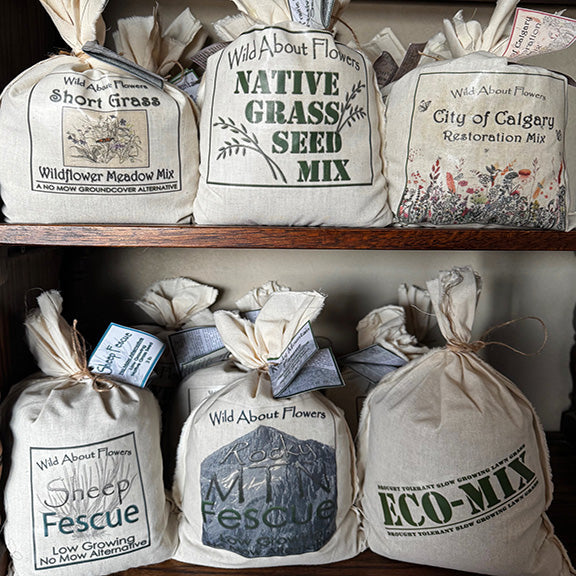Collection: Native Grass Seed & Mixes
Native Grass Seed offers a resilient and eco-friendly alternative to traditional Kentucky Bluegrass lawns, which tend to be shallow-rooted, high-maintenance, and thirsty. In contrast, native Fescues and other grass species develop deeper root systems that help improve soil structure, reduce erosion, and require far less water once established. These grasses are well suited for low-maintenance landscapes, and several can be used effectively as lawn replacements.
Our pre-made native grass mixes are an excellent option for anyone looking to establish a more naturalized, meadow-like effect, whether in urban yards, acreages, or restoration projects.
Custom native grass seed and mixes are also available—please see our Bulk Seed and Custom Mixes section for details. Native grasses not listed on this site maybe be available, please inquire.

-
Rocky Mountain Fescue
$50.00 CAD -
Sheep Fescue
$40.00 CAD -
Eco-Mix Grass Seed
$40.00 CAD -
 Sold out
Sold outCity of Calgary Restoration Mix
$90.00 CADSold out
More Information
Seeding Rates & Coverage
Grass has a general seeding rate of 1 lb per 250 sq ft, which is ideal for lawns or areas where solid coverage is desired. If you're including wildflowers or aiming for a more naturalized look, you can reduce the rate to 1 lb per 750 sq ft. Native clumping grasses can reach diameters of 8" to 24", depending on the species and the space they’re given to grow.
Seeding & Germination Times
Native grasses are generally cool-season germinators, but they can be seeded throughout the growing season. You can sow them as soon as the soil is visible in spring to take advantage of the high moisture content and cooler temperatures—let nature do most of the work for you. These grasses are hardy enough to handle a late spring snowfall.
When seeding later in the season, once temperatures rise, it’s important to keep the soil consistently moist during germination. The hotter the weather, the more attention your seedlings will need. Grasses can also be sown in late summer, when cooler nights and overall milder temperatures help slow evaporation, reducing the need for frequent watering. If the seeds don’t germinate in the fall, they’ll wait and emerge the following spring.
Tips
• Check your soil moisture before seeding. If it feels dry, water deeply a day or two before sowing. Once the soil is firm enough to walk on, you can spread your seeds and just focus on keeping the surface lightly misted on warm days as needed.
• Divide and conquer. Section off the area you're seeding and divide your seed into the same number of portions as sections. This helps prevent over or under-seeding.
• Always hold some seed back. It’s helpful to have extra on hand to fill in any sparse or bare areas later.
Grass seed stores well. When kept in a cool, dry, and dark environment, grass seed can remain viable for several years. Alberta’s naturally dry conditions give you a head start when it comes to long-term storage.






